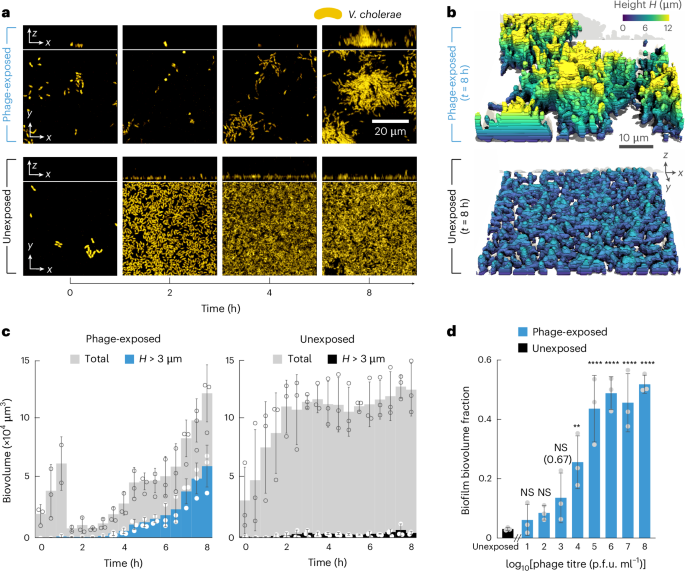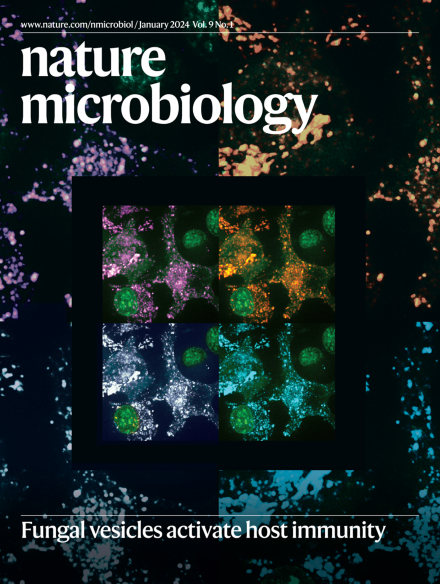细菌利用外源性肽聚糖作为危险信号触发生物膜的形成
IF 20.5
1区 生物学
Q1 MICROBIOLOGY
引用次数: 0
摘要
对于任何生物来说,提前感知和应对威胁的能力都能提高它们的生存能力。对于细菌来说,已经观察到亲缘细胞之间的危险感应,但对一般危险信号的存在或影响知之甚少。在这里,我们发现不同的细菌物种使用外源性肽聚糖片段,这些片段由附近的皮肤或非皮肤细胞裂解释放,作为一般的危险信号。利用显微镜和霍乱弧菌的基因表达谱,我们发现即使是短暂的信号暴露也会导致调节反应,导致三维生物膜的形成,从而保护细胞免受包括噬菌体捕食在内的广泛压力。多种多样的物种(铜绿假单胞菌、鲍曼不动杆菌、金黄色葡萄球菌、粪肠球菌)也通过形成生物膜对外源性肽聚糖产生反应。由于来自不同革兰氏阴性菌和革兰氏阳性菌的肽聚糖触发了三维生物膜的形成,我们认为这种危险信号和危险反应在细菌中是保守的。本文章由计算机程序翻译,如有差异,请以英文原文为准。


Bacteria use exogenous peptidoglycan as a danger signal to trigger biofilm formation
For any organism, survival is enhanced by the ability to sense and respond to threats in advance. For bacteria, danger sensing among kin cells has been observed, but the presence or impacts of general danger signals are poorly understood. Here we show that different bacterial species use exogenous peptidoglycan fragments, which are released by nearby kin or non-kin cell lysis, as a general danger signal. Using microscopy and gene expression profiling of Vibrio cholerae, we find that even brief signal exposure results in a regulatory response that causes three-dimensional biofilm formation, which protects cells from a broad range of stresses, including bacteriophage predation. A diverse set of species (Pseudomonas aeruginosa, Acinetobacter baumannii, Staphylococcus aureus, Enterococcus faecalis) also respond to exogenous peptidoglycan by forming biofilms. As peptidoglycan from different Gram-negative and Gram-positive species triggered three-dimensional biofilm formation, we propose that this danger signal and danger response are conserved among bacteria. Peptidoglycan released by neighbouring kin or non-kin cell lysis induces physiological changes that protect from a range of stresses, including phage predation.
求助全文
通过发布文献求助,成功后即可免费获取论文全文。
去求助
来源期刊

Nature Microbiology
Immunology and Microbiology-Microbiology
CiteScore
44.40
自引率
1.10%
发文量
226
期刊介绍:
Nature Microbiology aims to cover a comprehensive range of topics related to microorganisms. This includes:
Evolution: The journal is interested in exploring the evolutionary aspects of microorganisms. This may include research on their genetic diversity, adaptation, and speciation over time.
Physiology and cell biology: Nature Microbiology seeks to understand the functions and characteristics of microorganisms at the cellular and physiological levels. This may involve studying their metabolism, growth patterns, and cellular processes.
Interactions: The journal focuses on the interactions microorganisms have with each other, as well as their interactions with hosts or the environment. This encompasses investigations into microbial communities, symbiotic relationships, and microbial responses to different environments.
Societal significance: Nature Microbiology recognizes the societal impact of microorganisms and welcomes studies that explore their practical applications. This may include research on microbial diseases, biotechnology, or environmental remediation.
In summary, Nature Microbiology is interested in research related to the evolution, physiology and cell biology of microorganisms, their interactions, and their societal relevance.
 求助内容:
求助内容: 应助结果提醒方式:
应助结果提醒方式:


